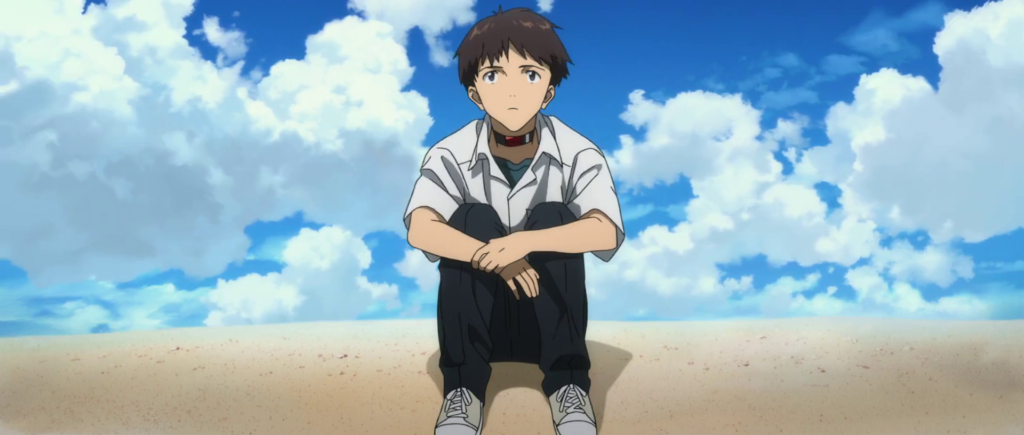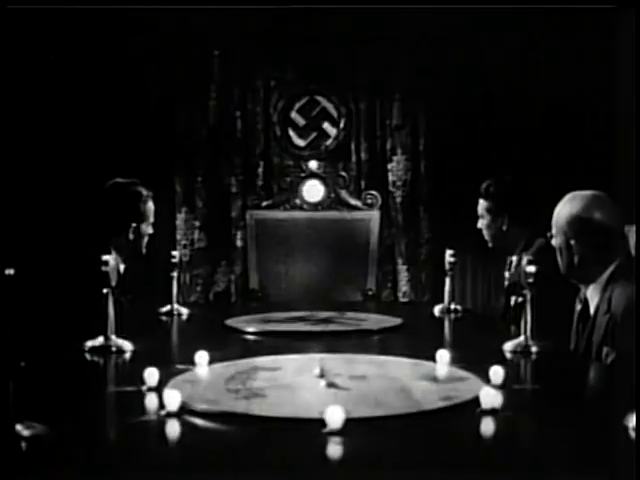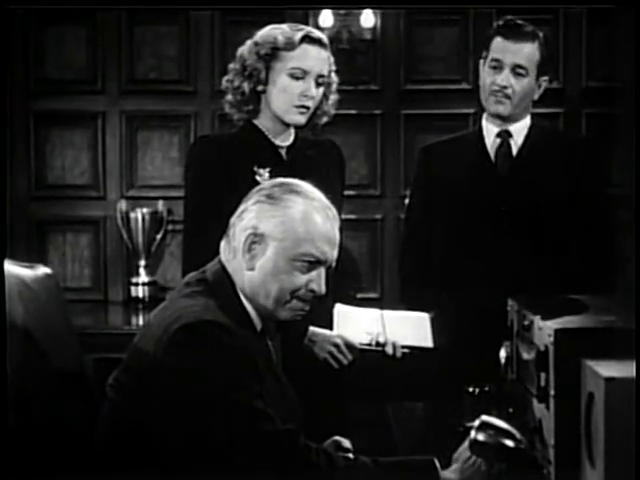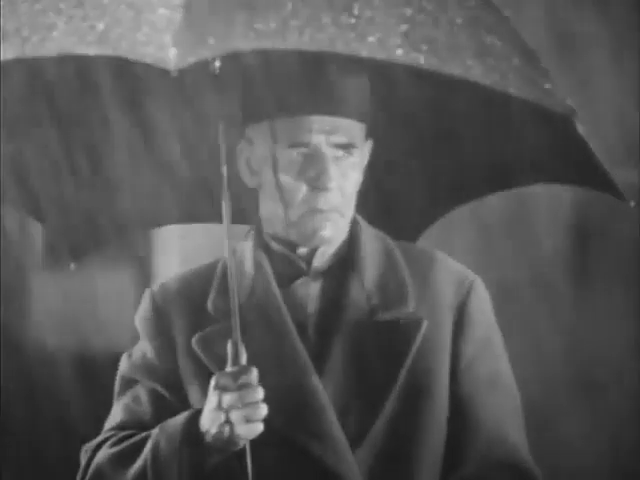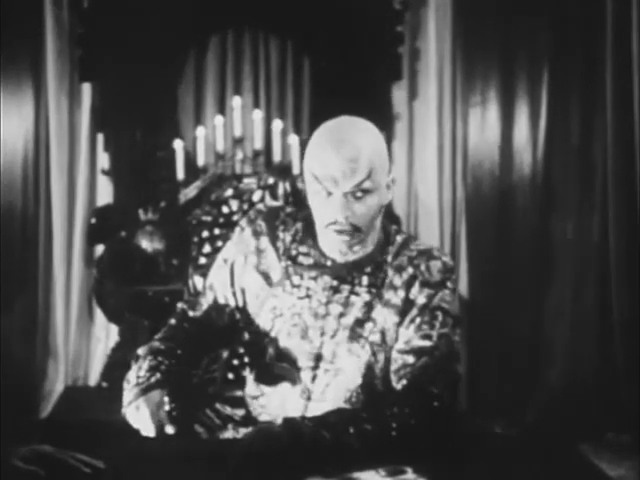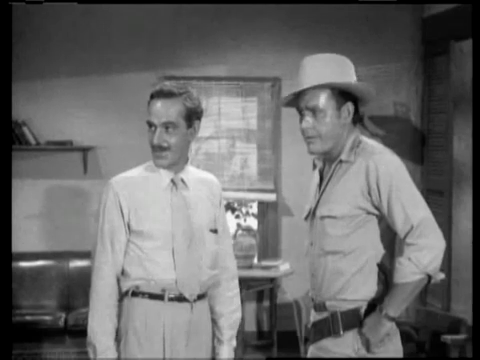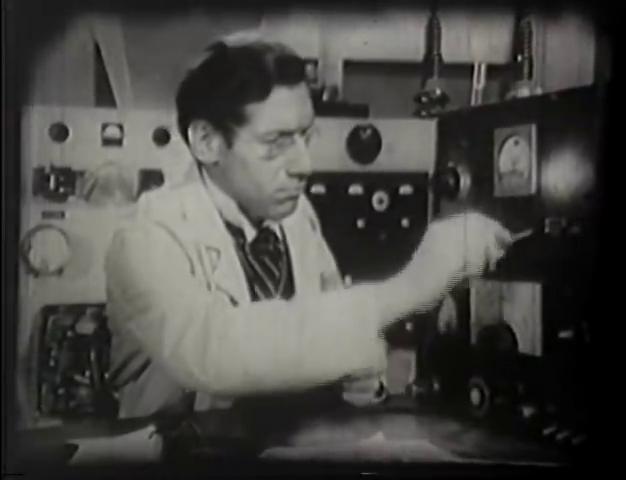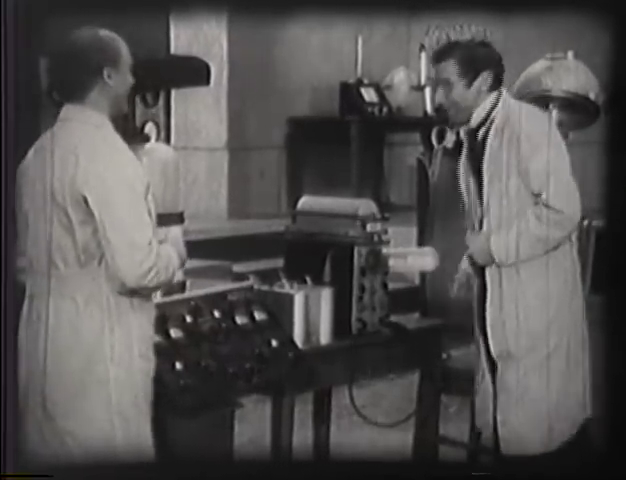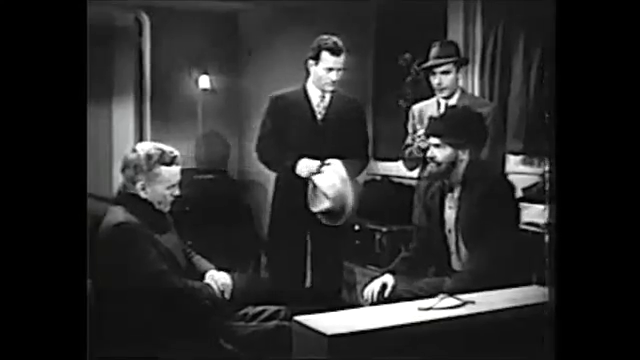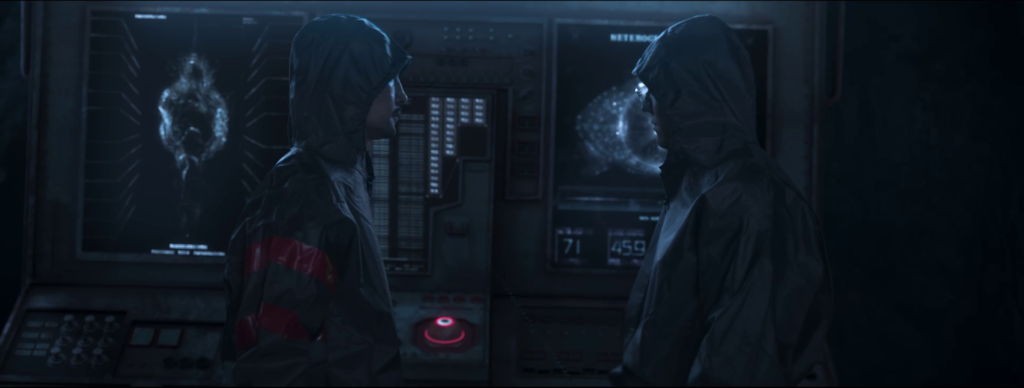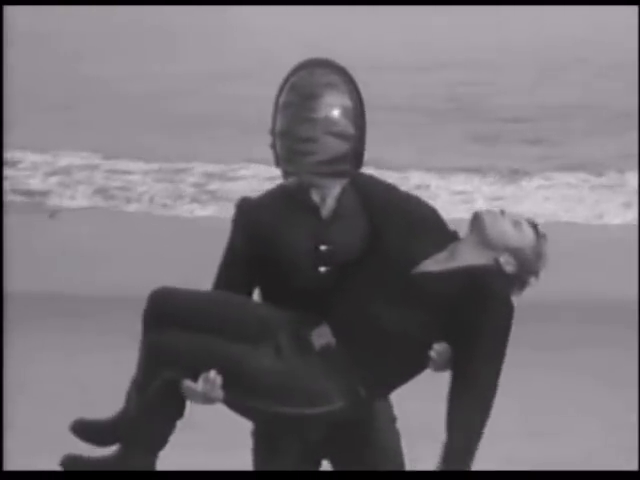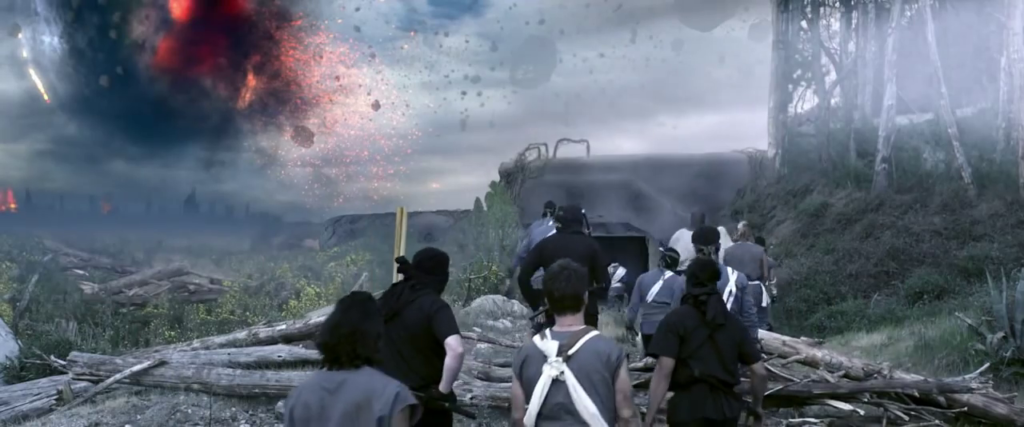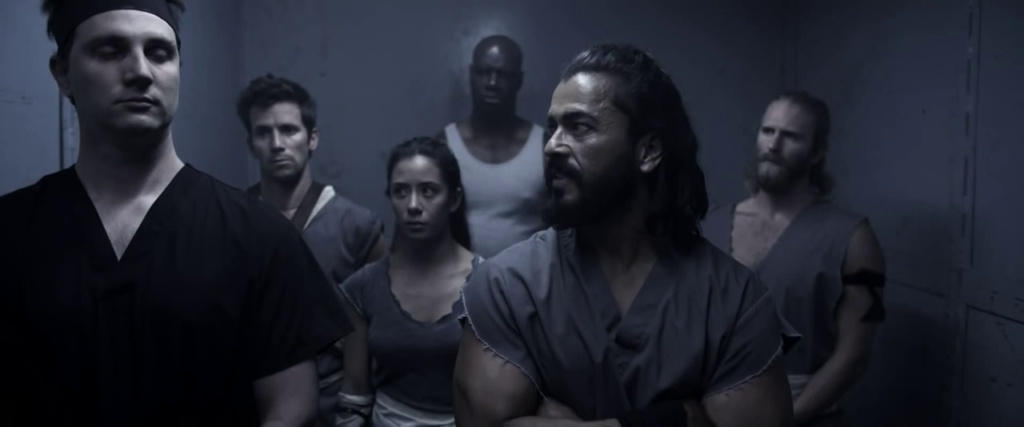-
#470 – Evangelion 3.0 + 1.0 Thrice Upon a Time
Evangelion: 3.0 + 1.0 Thrice Upon a Time (2021)
Film review #470
Directors: Hideaki Anno, Kazuya Tsurumaki, Katsuichi Nakayama, Mahiro Maeda
SYNOPSIS: Following the aversion of the fourth impact, the Eva pilots are left wandering the ruins of Tokyo-3 defeated and deflated, until they are picked up by familiar faces that take them to a settlement where people are surviving in the world that has been left behind by the pilots actions. They do their best to fit into this new world, but they know that their fight is not over, and the final battle to save humanity is edging closer…
THOUGHTS/ANALYSIS: Evangelion 3.0 + 1.0 Thrice Upon a Time is a 2021 Japanese animated film, and the fourth and final film in the Rebuild of Evangelion film series. The film starts out with a battle in Paris, where WILLE are attempting to restore the city to a habitable condition. They succeed, and the focus switches to the three protagonists who we saw at the end of the previous film, wandering the ruins of Tokyo-3 without purpose as their EVAs have been destroyed. They are rescued and taken to a small settlement where they meet some of their old school friends, who have now grown up, while they remain the same age due to a side effect of being EVA pilots. The first part of the film is set in this settlement as the three try to come to terms with what has happened and being around other people. It’s slow paced, but gives ample time to focus on each of the characters individually and their own personal journeys. Although the characters have been psychologically explored in the previous films, it still feels rewarding to do it again, and as this is the final film, provide some closure for their own individual journeys. The themes of finding your place in the world amongst others, and taking responsibility for your actions are fairly clear, and drive the character’s journeys and their individual responses. The plot structure of dedicating the first half of the film to this more slow-paced exploration and the latter half focusing on the action and lore is a good balance, and stops one interrupting the flow of the other. If you’re watching this film, it is probably not your first experience with the franchise, but if it is, you’re definitely not going to be able to keep track of everything that’s happening (this is also true if you’re a die hard fan, but in that case, you’re somewhat expecting not to get everything right away and that some things are open to interpretation).
The latter half of the film is when the action kicks in and the stakes get raised to infinity. The film manages to push itself even further than the TV series and End of Evangelion (The alternate telling of the TV version ending). All of the new elements that were added over the film series are addressed and resolved (apart from those which are intentionally left ambiguous). It even manages to incorporate the events of the TV series as somewhat canon. As such, it is a satisfying conclusion to the series that gives the characters the ability to look forward to the future. The action scenes constantly pile more and more things into them as it gets quite over-the-top, but again, it’s what you come to expect from the series. The characters don’t offer much in the way of surprise, but one or two of them get a small change or development that rounds off their characters, which is nice.
Accompanying the film is the usual over-the-top orchestral soundtrack and visuals that encompass the entire planet. The animation is pretty smooth, but the CG looks a bit unconvincing in some parts; I’m not sure if some corners had to be cut due to the pandemic, but for the most part, it still looks pretty good and consistent with the other films. With a runtime of over two and a half hours, the film feels like it says all it needs to say and do. Overall, Evangelion 3.0 + 1.0 is a satisfying ending to the series that takes its time to tie up its loose ends and give answers to questions that fans have been asking for over twenty years, while still retaining some ambiguity and open-endedness that is a trademark of the series. It definitely feels like there were no constraints with regards to budget or runtime, so the story that Hideaki Anno wanted to tell is told in its entirety. Some small and minor bumps in the animation don’t really hinder the film’s message and execution, and as such it is a solid ending to the film series. It’s definitely not a point to jump into the franchise, but the film series as a whole tells the story of Evangelion in the form I think it was meant to be experienced.
-
#469 – The Master Key (1945)
The Master Key (1945)
Film review #469
Directors: Lewis D. Collins, Ray Taylor
SYNOPSIS: A secret Nazi organisation operating in the United States has kidnapped Professor Henderson in order to force him to finish his “auratron” invention that can make gold out of seawater, and use the gold to fund the Nazis operations. Tom Brant, an FBI agent, hunts down the Nazi spy ring with the help of Detective Jack Ryan and his contacts in the police force to find Professor Henderson and bring the Nazis to justice.
THOUGHTS/ANALYSIS: The Master Key is a 1945 serial released by Republic Pictures and comprised of thirteen chapters. The serial centres around a Nazi spy ring operating in the United States, who kidnap Professor Henderson and force him to complete his “auratron” invention, which can turn seawater into gold, which the Nazis will then use to disrupt America’s industrial might. The only thing standing in the way of their evil plans is FBI agent Tom Brant and his companions in the police department. The plot centres around this Nazi spy ring who identify themselves with a key that has the letter “M” and a number engraved on it. They are given their orders by the “Master Key,” who conceals their identity from even the group. That’s all the “Master Key” of the title refers to, and yes, it’s a rather uninteresting premise, given the keys serve no purpose other than to identify the spies, and are used at the start of each chapter to “summon” the master key who explains the plot. The main focus of the plot is Henderson’s invention which apparently turns seawater into gold, an idea which is sounds ridiculous even by the serial format’s standards. The chapters involve the typical plot structure of the heroes trying to rescue the professor and his invention…the amount of serials that enact this same plot is too many to count, and most of them do it better than this one. The plot has very little direction otherwise, and the back-and-forth between the protagonists and antagonists is painfully slow, and explained through long scenes of exposition that slow the pacing down to a crawl. There’s some cliffhangers that incorporate more impressive large crashes or explosions, but they are usually, and obviously, stock footage or models, and the fallout is never really shown, only explained further with the shot of a newspaper front page and even more dialogue.
The characters are the usual bunch you associate with the serial format: there’s the young male leads who get into the fights, the older men who serve as support, and some token women who get the role of journalist or secretary. The villains likewise are uninteresting and have no character or role other than being henchman. The main villain we never see until the very end, instead giving orders through some sort of radio…thing. There’s constantly very little for the viewer to grasp a hold of, and as such, it is difficult to maintain attention on the serial as a whole. There’s some supporting characters including a bunch of younger street-wise teenagers who help out under the watch of Aggie, a similarly street-wise woman. Again, none of the characters really stand out or do anything of merit.
Released in April 1945, The Master Key was released in the very dying days of World War II. As such, it is difficult to see how relevant the whole Nazi spy ring plot was. The wartime serials typically focused on Japan as the primary U.S. enemy, and choosing the Nazis as the villains is perhaps an odd choice at this time. Each chapter opens up with a disclaimer of sorts saying that the serial is fiction that “could never happen,” and states that it takes place in 1938 before the war even started. I assume this was in order to keep the serial in line with the requires of the regulatory bodies, perhaps setting it before the war was necessary to not give the illusion that the Nazis were still a threat to the US in the then dying-days of the war, and that the U.S. was too powerful for something like this to happen anyway. It’s interesting then that they allowed it during wartime: perhaps they needed people to be on their guard, but on the verge of the Nazis being defeated, the tone changed to saying that there was no way that anything like this could ever happen to America. It’s also interesting that the serial clearly identifies the enemies as Nazis and shows their flags in their hideout: again, most serials previously did not mention the Nazis by name or show any of their insignia, instead showing enemies that were working for a “foreign power” which obviously was meant to be the Nazis. Again I assume the requirements of the film regulators changed at the end of the war, and by being able to identify them and place them in the past, it signified that they were a product of history, and no longer a real threat. Also a small note concerning the invention that can apparently turn seawater into gold: it’s so outlandish and nonsensical even by serial standards that it’s very hard to take seriously.
Overall, The Master Key is a poor showing, released at the wrong time. It has very little direction in terms of story or characters, and the long-winded scenes of dialogue and exposition overshadow any action scenes. It exists at a strange point in history where the Nazis were no longer credible or interesting villains, but also before the post-war serials, which turned either to America’s military war heroes battling foreign spies (implied to be the soviet union) or more sci-fi adventures. As such, The Master Key falls between the cracks and fails to find very little relevancy or entertainment value.
-
#468 – Drums of Fu Manchu (1940)
Drums of Fu Manchu (1940)
Film review #468
Directors: William Witney, John English
SYNOPSIS: Villain Fu Manchu intends to locate the sceptre of Genghis Khan, and use its ancient powers to conquer all of Asia. When his Father is killed by Fu Manchu in pursuit of the sceptre, Allan Parker teams up with Sir Dennis Nayland Smith and his assistant Dr. Flinders Petrie, who have fought Fu Manchu in the past. Teaming up with the British army stationed in Asia, they hurry to find the sceptre and Genghis Khan’s tomb before Fu Manchu can do the same…
THOUGHTS/ANALYSIS: Drums of Fu Manchu is a 1940 serial by Republic Pictures comprised of fifteen chapters, and based on the series of novels by Sax Rohmer (Drums of Fu Manchu is the ninth novel in the series, but the serial borrows plot points from the whole series). The serial starts out with Fu Manchu outlining his evil plans to conquer Asia, using the power of the sceptre of Genghis Khan. In order to track it down, he leaves a trail of death and destruction in his wake as he tracks down the clues to his location. Allan Parker is caught up in Fu Manchu’s schemes as his Father is killed by Manchu’s henchman, and looking to get revenge, Allan teams up with Sir Dennis Nayland Smith, Fu Manchu’s old adversary. The plot of the fifteen chapters unfolds in typical serial fashion, as each chapter inches the plot forward as the heroes and villains engage in a back-and-forth of schemes and counter-schemes to try and outdo each other. Where the serial stands out is its varied settings and action sequences, which are fairly well thought out and keep things interesting. The serial borrowing the best bits from the series of novels probably helped in generating ideas for the fifteen chapters. There is, however, a fair amount of repetition in the serial, particularly in the fact that a lot of the plot is driven forward by one side overhearing the other’s plans, and a counter-scheme being devised. It’s a bit predictable, but that’s very much a staple of the format. The serial does fortunately have a very definite sense of direction, and each chapter edges the plot forward a little towards a goal that is defined from the outset, and simple enough to follow.
The characters are all fairly standard for a serial, with Allan Parker being the typical action-based male lead who does all the stunts and fistfights. Nayland Smith is the protagonist of the novels, but takes a supporting role here, as these serials always require a more action-based lead. The usual lack of female characters are also featured in the serial, with Mary Randolph being the sole female lead who appears very infrequently and provides no contribution to anything other than being the daughter of another more important character. There’s also Fu Manchu’s daughter who plays a role as a minor villain. Obviously the most interesting character is Fu Manchu himself, a villain that has become somewhat cultural icon…for better or worse. His iconic image is fairly recognisable, and he has been the focus of quite a few movies across the decades, meaning his image has become this recognisable figure. As you might expect however, this image is mired in controversy, and has cemented a specific image of “orientalism” in the west for many years (obviously Fu Manchu wasn’t the first character to do this, but his is one of the most enduring). He is played, as most southeastern Asian characters are, by a white man in make-up to “look” Chinese. His attitudes and actions also accentuate a “foreignness” that portrays a difference and opposition to western values. He is definitely one of the more interesting villains seen in a serial, but it relies on some very problematic depictions.
Drums of Fu Manchu is regarded as one of the best serials that was produced, and it easy to see why: the action sequences are varied and intense, and there’s a lot of effort put into the serial in all of its aspects. A lot of consideration is put into depicting Fu Manchu as evil, particularly in the harsh lighting shots that create shadows across his face and give him a very malicious look. A rather unique aspect of this film is the ending, in which Fu Manchu actually survives and escapes the plunge to his doom, promising revenge. It was actually against the film regulator’s guidelines to have film villains survive at the end, presumably as it was morally important to show villains getting justice for their crimes (even if that justice is being hurled off a cliff…). Apparently, an exception was made because the novels had Fu Manchu escaping at the end, and also that the series very much had the potential for a sequel in which Fu Manchu could ultimately meet his end. I think there definitely would have been a sequel, but apparently the U.S. state department put a stop to it because the Chinese ambassador to the U.S. had formally complained about the depiction of Chinese people, and China was also an ally in World War II against the Japanese. This is also probably why the villains in wartime serials were typically Japanese from that time forward. Overall, Drums of Fu Manchu is a good example of the serial format, but comes with a big caveat in its problematic depictions of Chinese people and Asian cultures. The plot has direction, the action sequences are varied and well executed, and there’s generally a good amount of consideration and effort in most of the film’s production. It is easy to see why it is one of the strongest examples of the serial format, although as with the rest of them, it suffers from a fair amount of repetition.
-
#467 – Panther Girl of the Kongo (1955)
Panther Girl of the Kongo (1955)
Film review #467
Director: Franklin Adreon
SYNOPSIS: Jean Evans, a member of a wildlife foundation, is in Africa taking photos of local wildlife when she encounters a giant crayfish that nearly kills her. She teams up with Larry Sanders, a big game hunter, to stop the creature and discover it’s origins.
THOUGHTS/ANALYSIS: Panther Girl of the Kongo is a 1955 serial produced by Republic Pictures and comprised of twelve chapters. The serial centres around Jean Evans, who works for a wildlife foundation taking photographs of wildlife. She is known as “Panther girl” because…I don’t know, she rides an elephant sometimes and dives off cliffs; the only panther I recall seeing is at the end screen. Anyway, she encounters a giant crayfish that attacks her, but is saved by Larry Sanders, a big game hunter in the area. The two team up to try to stop the monster and unravel the mystery of it’s origins, while trying to stop two outlaws in the area. This is the cornerstone of the plot, alongside Dr. Morgan, a scientist also in the area, has created the giant monster to scare off people from a mine full of diamonds while he harvests them all. Obviously, this type of plot has been done to death, and is perhaps more famously associated with a vast chunk of episodes of Scooby-Doo, meaning it’s hardly an interesting watch nowadays when it’s been done and done again. There’s also not much of a plot besides this, and the heroes trying to stop the giant crayfish monster thing. Trouble is, it doesn’t show up for a good chunk of the serial, and so Jean and Larry are left to do the typical back-and-forth with Morgan’s henchman, as they make plans, set traps, and start fistfights with each other. As it is, the plot rarely has any direction, and the stakes are also pretty low, since again it’s not all for world domination or anything, just a man wanting to mine some diamonds in the middle of nowhere.
Quite rarely for a serial, the main character is a woman. Jean Evans is the “panther girl” due to her prowess in the jungle (even though there’s no panthers that we see), and she actually does something other than being kidnapped. The only other serial that does this to this degree is perhaps Jungle Girl (more on that later). However, when the script requires it, she does revert to the typical screaming damsel in distress, and the male lead swoops in to save her. He also does most of the shooting and punching, but still Jean’s character is central to the plot. Larry is just a typical male lead with no real character. The villains also are just typical henchman and a “mad” scientist who isn’t all that mad, just wants to get rich. The setting of non descript “Africa” and its stereotypical depiction of “tribes” is problematic and presenting the entire continent in this way is a depiction that prevailed for decades thanks to films such as these.
The serial is quite similar to the Jungle Girl serial released in 1941, particularly with regards to a jungle-savvy female lead. This is also not coincidental, as this serial uses a lot of the footage from the serial, particularly the on-location stuff and animals. In 1955, the serial format was really on it’s last legs, and it’s no surprise that the studios wanted to do as little new stuff as possible (although cost-cutting and re-using footage has been a staple of the serial format for years at this point). Since Jungle Girl was released fourteen years before, and theatre-goers probably wouldn’t have seen it or forgotten about it due to the lack of home media releases, and the only way to see older serials would be to watch re-releases at theatres, which I believe were somewhat rare, and even then they really don’t benefit from repeated viewings. The re-used footage is pretty heavy in the finale, when the action sequences are almost entirely made up from this footage, and the transition between the different footage is very awkward and disjointed. For example, you can clearly see “Jean’s” outfit change from scenes as she instantly switches from a miniskirt to swinging from the trees in leggings. The “giant” crayfish is obviously not a giant one, just a regular one filmed amongst miniatures. It’s not particularly convincing, especially when the “giant claw” attacks people with the rest of its body just offscreen. Overall, Panther Girl of the Kongo is a fairly weak serial, in which it’s most interesting aspects are just bits of re-used footage. The plot is non-directional and has fairly low stakes, alongside often feeling it’s just padding for the more interesting re-used footage. The emphasis on the female lead is a more unique aspect, but she is reverted to the typical “damsel in distress” when the plot wants to do a more typical set-up of the female being the victim. The serial is very low on imagination and spectacle, and is emblematic of the serial format in it’s twilight years as the format became unviable with the introduction of televisions in homes.
-
#466 – The Lost Planet (1953)
The Lost Planet (1953)
Film review #466
Director: Spencer Gordon Bennet
SYNOPSIS: Investigating a suspected U.F.O. crash in the mountains, reporter Rex Barrow and photographer Tim Johnson head there to check it out, but find themselves captured and sent to the planet Ergro by scientist Dr. Grood, who sends them to work on the planet to mine minerals and build his inventions to take over the universe. Rex, Tim, captured scientist Professor Dorn and his daughter Ella must overcome Grood’s mind control device and other contraptions as they try to put a stop to his evil plans…
THOUGHTS/ANALYSIS: The Lost Planet is a 1953 serial produced by Columbia Pictures and comprised of fifteen chapters. It is the last science-fiction serial that the studio produced (although the studio itself only produced three serials which could be fully described as “science-fiction”). The serial starts out with reports of a flying saucer crashing on Mount Vulcan, and reporter Rex Barrow and photographer Tim Johnson go to investigate, but end up getting captured along with Ella Dorn, and taken by rocket ship to the planet Ergro, where evil scientist Dr. Grood has taken over the planet to mine a new element that fuels his evil inventions. The plot of the serial revolves around trying to stop Grood and his various inventions, most notably his mind control device, which places prisoners in his power. It’s not only that though: this element that Grood is mining also fuels inventions such as a death ray, mind-reading device, invisibility and a whole host of other sci-fi tropes. Normally just one of these inventions would be enough for a serial to focus on, but here they’re all thrown into the mix. While this helps with keeping the serial varied across its fifteen chapters, it also has the effect of having little focus on any one of them. The one which stands out most is the use of the mind-control/hypnosis device. which is probably the least interesting of them all, and a lot of the plot just revolves around being hypnotised and de-hypnotising certain characters, creating a predictable back-and-forth.
One of the interesting aspects of this serial is that it seems to have been planned to be a sequel to the Captain Video serial. A lot of the same actors return, and the costumes and props are obviously re-used from it (for example, the outfits of the “video rangers” are used for the uniforms of the brainwashed people on Ergro). Whether the idea of making this a sequel was scrapped early on for some reason is anybody’s guess. The characters themselves are an unassuming bunch, and fit the typical parts that these serials provide. Unlike Captain Video though, this serial actually has a female character, although as usual, her only noteworthy aspect is being related to another more important male character. There’s a number of villains that have their own unique personalities and play off against one another, but it never really develops into something remarkable, and the web of villains just becomes confusing and muddled. Particularly as the serial switches between Earth and Ergro constantly.
In terms of production, there’s some decent sets in this serial. The rocket ship looks good, and the space travel sequences between Earth and Ergro look pretty good, considering in 1953 no one had ever been into space. The acting is not great, but there’s definitely worse performances I’ve seen in serials. It might have gotten away with it, but some of the dialogue is pretty dull and loaded with technical jargon that the actors seem to be convinced about saying. One other problem is that both Earth and Ergro look exactly the same; obviously because both are filmed in the California hills like every other serial, and as such this adds to the confusion surrounding the story, as both planets look so alike you don’t know where you are some of the time. Another curious decision about the making of the serial is that there’s none of the typical fistfights you get in nearly every serial: the only time someone throws a punch is when Rex is turned invisible, and so even then, you can’t see him actually throw the punch. This is incredibly strange, most notable because Spencer Gordon bennet, the director, practically invented the choreography for serial fistfights. Maybe they wanted to focus on the scientific inventions and their varied effects for the action, but even then, as mentioned, this is only the third sci-fi serial Columbia made, and it seems a bit out of their comfort zones.
Overall, The Lost Planet is a bit of a mess, and suffers from attempting to do too much. The inventions and sets are cool, but they’re all just props without a decent plot to coalesce around. The stakes are pretty detached as most of the action unfolds on this non-descript planet, and the characters fail to make an impact despite having such a large cast. The lack of action in this serial is very questionable, and the array of inventions don’t really fill in the gap. The whole serial is full of typical set-ups and schemes, but fails to give any motivation for the characters, or direction for a plot to develop.
-
#465 – T.O.R.R. Dawn of the Red
T.O.R.R. Dawn of the Red (2011)
Film review #465
Director: Robert Towne
SYNOPSIS: In the near-future, global instability and war is rife, and the CIA recruits army Captain Beck for a mission deep into enemy territory, where he and his team are to stop a Russian warlord from unleashing a new biological weapon…
THOUGHTS/ANALYSIS: T.O.R.R. Dawn of the Red is a 2011 action film. Set in the “near-future” of 2014, the world is in a period of instability, with new wars and separatism rife across many countries…apart from the United States, which seems to be carrying on as normal (American exceptionalism means those sorts of things never happen there). Captain Beck, a member of the U.S. Army, is summoned by the CIA to escort one of their agents, Sophie Delgado, deep into hostile Russian territory to prevent a local warlord from releasing a new biological weapon. The plot in this regard is simple to follow: it is an action film with a team of soldiers going into enemy territory to stop the bad guy. You don’t need much more than that. When the film tries to create more of a story behind the motivations of the mission and characters, it falls down a little because the dialogue is lacking in impact due to a combination of unconfident acting and muffled audio (more on that later). The editing also hinders this, with cutaways that are meant to explain the plot hurting the pace of the film, and feeling more like an exposition dump. You won’t be expecting too much from the film’s story, but still, it’s confusing details and detours detract from the action-oriented nature of the film as a whole. There’s also some pretty funny moments which I’m not sure are intentionally meant to be, such as a terrorist jumping out of a fridge opening fire, which again makes the tone of the film quite uneven, as you’re not sure how seriously you’re meant to take everything.
The characters again are pretty consistent with the genre, with the main character Beck being a chauvinistic soldier with an attitude problem towards escorting a woman. That’s his only personality trait. Agent Delgado as the only female character obviously conflicts with Beck, but it never develops into anything unique. Perhaps quite surprisingly, it also doesn’t develop into something romantic, which is usually how these things usually go in films. The rest of the cast are pretty forgettable, apart from the Russian warlord “Rasputin,” who is definitely overplayed and hyped up as a villain, even though he’s not really around too much. The characters are further diminished by some very poor acting, and a number of times the actors mess up their lines, and obviously a second take should have been done.
About halfway through the film the action changes tone a bit as we are treated to…zombies. It turns out this biological weapon turns people into “reanimated” corpses, and the team have to fend off waves of zombies instead of soldiers. Again, the tone of the film is subjected to an unexpected change that isn’t set-up, and you’re left wondering how seriously to take everything as the military action switches to this horror zombie survival plot. I suppose the title “Dawn of the Red” is meant to be a double reference to the films Red Dawn and Dawn of the Dead, which I guess this film could be seen as a combination of, and hints of what to expect, but that’s a stretch (I also have no idea what T.O.R.R. is supposed to stand for).
This is obviously a low-budget film, and so there’s a number of production issues that are very distracting and disrupt viewer’s immersion. Apart from the shaky acting mentioned above, the dialogue is very inorganic, and attempts to wax philosophical come across as unoriginal and not worth listening to. Apart from the choppy editing that breaks up the action, one of the most distracting things is the poor quality of the audio and how everyone’s voices are muffled or echoes significantly. Some of the zombie/reanimated make-up is very obviously fake as well, but the film hides it a bit in dimly lit rooms. The lighting overall is also something that stands out, with a lot of scenes being filmed in this weird night-vision which creates a high contrast and obscures some of the action. There’s some attempt to create different lighting effects depending on the situation, but they are typically overpowering. The low framerate of the cameras being used also lead to significant blurring, particularly during the action scenes, which means you can barely tell what’s going on sometimes, and combined with the poor audio, makes it completely unengaging. In a more positive respect, the film makes use of a variety of on-location sets, from deserts to snow-covered forests, which is better than similar low-budget films that might confine themselves to abandoned buildings or greenscreens (of which there are none that I could see in this film).
Given that this is an independently made film without much budget, it is unfair to compare such films to big-budget Hollywood productions. However, even in the context of independent films, T.O.R.R. leaves very little to recommend it. The plot is an unsynthesised mix of military action and zombies that is inconsistent, and the mix of action, horror and silly one-liners will leave viewers alienated from anything that goes on screen as they’ll be left wondering how to connect with what is happening. The story and characters are completely forgettable, and the poor dialogue and delivery of lines further stifles engagement. While there’s obviously been a decent amount of effort put into this film with regards to location shots, and getting authentic looking weapons, the poor audio and blurry visuals combined with obtuse selection of lighting makes many scenes incomprehensible, and ruins most of the positive moments the film has. Overall, I don’t think there’s anything unique or interesting to recommend here.
-
#464 – The Great Alaskan Mystery (1944)
The Great Alaskan Mystery (1944)
Film review #464
Directors: Lewis D. Collins, Ray Taylor
SYNOPSIS: Dr. Miller, along with Dr. Hauss, has invented a new death ray called the paratron. However, Dr. Hauss is secretly a Nazi spy, who intends to steal the death ray to give to his home country. Jim Hudson, an adventurer of sorts, tells Miller that the material he needs to complete the paratron may be found in the Alaskan mines, and so they set off there, only to have their plane crash on the way…
THOUGHTS/ANALYSIS: The Great Alaskan Mystery is a 1944 serial released by Universal pictures comprised of thirteen chapters. The serial centres around the invention of a death ray called the “paratron,” invented by Dr. Hauss and Dr. Miller. However, they are having trouble completing it. Jim Anderson, an adventurer who knows Dr. Miller’s daughter Ruth, visits and remarks that a rare mineral that can be found in mines in Alaska might be what they are looking for. They all set out on a boat to Alaska, but various machinations are at work, as Dr. Hauss is secretly a Nazi spy, and intends to steal the paratron for his own country, getting the Captain of the ship to aid him in his scheme. The ship sinks and the cast are forced to survive in the Alaskan wilderness until they are rescued. The first two or three episodes are quite varied and dump the cast straight into the Alaskan wilderness doing what you would expect them to di in Alaska: getting caught in the snow, visiting Inuit natives, and such. After chapter three, the serial settles down into a more typical format, with the heroes and villains engaging in a back and forth as they try to get a hold of the paratron and stop each other. In terms of story then, it’s a standard serial affair. The stakes aren’t particularly high as everything revolves around this death ray which while is indeed powerful, doesn’t seem as revolutionary as some other inventions used in these serials (maybe because the idea of the death ray has been done to death). Also this is a wartime serial, and the stakes here probably pale in comparison to the real war going on at the time. There’s also perhaps something to be said for the fact that the setting of Alaska makes the serial feel somewhat removed from any wider context. However, the serial does make good use of the Alaska setting, as we get a decent amount of shots of the wilderness and unique set-ups in the mountains and snow, even if they rely heavily on stock footage.
The cast for this serial is fairly large. However, none of them really stand out, and fall into very typical serial roles. The cast does however, consist of a number of popular and well-known actors of the time, which enhances the serial with some decent performances. You have the typical protagonist, the sole female character, and the elderly scientist, along with the villains and their henchman. There’s also plenty of characters pretending to be helping the heroes when they are the villains. it all adds up to quite a mystery, but never really flows into a coherent experience as all the characters are easy to get mixed up and don’t form their own unique performance.
As mentioned, the depictions of Alaska are perhaps the most unique part of the serial, with plenty of scenic shots, lumberjacking, and wilderness sets that make it look the part. The dialogue is what mainly drives the story though, as with most Universal serials. There’s not a lot of action scenes outside of some classic shoot-outs and chase scenes, and again that is typical of a Universal serial, which usually are less action-oriented than the ones from rival serial producer Republic. Overall, The Great Alaskan Mystery has many of the serials tropes that it needs to, but fails to bring it’s busy story and large cast together to create anything special. It’s got everything it needs, but is ultimately a bit forgettable, leaving it to be remembered as just another average serial amongst the many of the format.
-
#463 – Alien Invasion (2020)
Alien Invasion (2020)
Film review #463
Director: Yun Xiang Lin
SYNOPSIS: Private detective Xu Siwei is hired by Yang Lin to investigate the disappearance of her Father. They are led to a secret underground facility where they encounter a strange portal to an alien world. Barely escaping the alien horrors within, Xu is haunted by strange dreams that relate to this alien species, and heads to the town where Yang Lin was raised to find answers…
THOUGHTS/ANALYSIS: Alien Invasion is a 2020 science fiction film. The film starts off in a secret laboratory where an experiment on an alien portal goes wrong and a creature escapes into the laboratory, forcing it to be sealed to prevent the alien’s escape into the world. Next, we are introduced to private detective Xu Siwei, who after capturing a thief returns to his home to find Yang Lin, a young woman who wants to hire him to find her Father, who went missing fifteen years ago. The two are led to a secret laboratory where they stumble upon the alien portal from the opening of the film. They manage to escape, but Xu starts having recurring nightmares about the aliens, and seeks to unravel the mystery further by visiting Yang Lin’s hometown, where strange things are happening. The plot of the film is inspired by the Cthulhu and other such eldritch horror, as the alien in the opening scenes shifts its amorphous form and impales people with its tentacles. The film is essentially a science-fiction thriller, attempting to build tension in the mystery it creates and the environments in which it is set. The film struggles to do this successfully because the whole tone of the film is very inconsistent: at the start there’s some more action and quirky light-heartedness, as Xu is clearly emulating Benedict Cumberbatch’s portrayal of Sherlock Holmes. The film leans more towards a horror theme as Xu and Yang investigate the laboratory, and more of a slow-paced thriller as Xu and Yang investigate what happened to her parents in the town she grew up. With these constant shifts in tone, the flow of the story is constantly interrupted and it it becomes difficult to maintain engagement in the story.
The film centres around the two main characters Xu Siwei and Yang Lin, who investigate Yang’s father’s whereabouts after he disappeared some fifteen years ago. As mentioned, Xu is clearly ‘inspired’ by Cumberbatch’s portrayal of Sherlock Holmes, but that part of his character doesn’t really factor in after the first act when the film shifts to a thriller and the mystery overshadows any character quirks. Yang has plenty of mystery about her, but there’s nothing too special about her character. The chemistry between the two is alright, but could probably have been pushed further to increase the stakes. Overall they’re pretty standard characters from the genre, but still fairly likable, and supplemented by decent acting on behalf of the actors.
The film is very much on par with other Chinese science-fiction released around the same time in terms of production, which means in terms of the CG is that it doesn’t look too bad, but it also typically looks like someone put it together in After Effects in an afternoon. The colour is one thing that I think stands out, as it is vivid without making the scenes lose their tense atmosphere. The practical effects look pretty daft, particularly the aliens which are obviously people in very silly looking masks that are quite distracting. The fact that we don’t see any of the aliens for a good majority of the movie again breaks the sense of flow, as we are treated to this set-up at the start, then nothing really comes of it for most of the movie. The whole mystery surrounding Yang’s mother and father also never gets a satisfactory payoff, as everything is delivered in cryptic riddles and not explained properly. Overall, Alien Invasion is a fairly standard Chinese science-fiction film of its type, and is unremarkable in terms of story, characters or production. It’s inspirations are obvious, and does little to develop or explore them in any unique way, making it a fairly forgettable experience.#movie#movie review
-
#462 – Mysterious Island (1951)
Mysterious Island (1951)
Film review #462
Director: Spencer Gordon Bennet
SYNOPSIS: A group of soldiers fighting in the American civil war are captured by Confederate forces. They eventually escape on an observation balloon, but find themselves drifting for days, eventually landing on a desert island far from civilisation. However, the island is far from deserted, as a native tribe, pirates, aliens, a castaway, and a mysterious masked man are all up to various schemes on the island, and the new arrivals must find a way to survive against all these different factions and find a way home…
THOUGHTS/ANALYSIS: Mysterious Island is a 1951 science-fiction serial comprised of fifteen chapters. It is based on the novel of the same name by Jules Verne. The serial is set in the year 1865, during the American civil war, where during the siege of Richmond, Virginia, Captain Cyrus Harding is captured by Confederate forces and taken prisoner. he engineers an escape with some other prisoners by hijacking an observation balloon. Unfortunately, a storm sweeps the balloon way off course, leaving it to drift for many days. When it lands, the crew find themselves on a desert island far from any civilisation, with no way home. They quickly find that the island is far from deserted however, and the new arrivals must contend with multiple factions and their schemes. As mentioned, the serial is based on Jules Verne’s novel of the same name, and incorporates a fair amount of the novel’s structure and characters. This is in contrast to a lot of serial adaptations of comics and books, in which usually only one or two main characters are made to fit into the serial format, omitting a lot of the original’s world and set-ups (such as things that would be too expensive to implement). As such, the serial has a good flow and pacing that keeps things interesting across the fifteen chapters. There’s still plenty of tried serial tropes when characters set up elaborate deaths with plenty of opportunity to escape rather than just killing them, but on the whole there’s plenty going on between all of the different factions to keep things varied and interesting. Even through the fifteen chapters, which is at the longer runtime of these serials, it keeps things consistently entertaining.
Let’s talk about the characters in this serial: there is a very large cast, and multiple different factions that are working against each other. Apart from the main cast that wind up on the island, there’s the native population, a castaway that has gone mad, pirates, aliens from the planet Mercury, and a mysterious masked man. In keeping with the novel, all of these characters are from the source material apart from the aliens from Mercury, which were added for the serial. The serial could have easily got away with not adding them, as there’s plenty of characters and plot anyway, but I suppose they were added to keep up with trends, as sci-fi serials and films started to get more popular after World War II had ended and the subsequent years in which war heroes were the protagonists of choice. The alien characters and plot fit in fairly well and are incorporated into the story so that they don’t stick out as a forced inclusion, which is good. While none of the characters are really unique or memorable, they have a consistency in their acting, and you know who they are and who they’re aligned with when they’re on screen. The heroes are perhaps the least interesting bunch, as they’re all typical young male leads without any special talent or occupation. Nevertheless, you will be on their side as they try and make their way home.
Mysterious Island is a nice surprise in the period of the serial format’s declining popularity. Obviously helped by being based off a famous novel helps give the story an interesting set of characters and set-ups, the serial also incorporates its own elements which, while nothing unique, is integrated nicely with the rest of the source material, even if the sound of pirates, American Civil War, and aliens together sounds like an absurd mix. The acting is decent, the sets convey a consistent sense of location, and the story has a good sense of direction that maintains interest and excitement. Spencer Gordon bennet, the director, was a serial veteran by this point, and delivers his usual developed choreography in fight scenes and keeping the pace of the serial steady yet energetic. Overall, Mysterious Island is a surprisingly decent addition to the serial format, at a time when good examples of it were few and far between.
-
#461 – Ninja Apocalypse (2014)
Ninja Apocalypse (2014)
Film review #461
Director: Lloyd Lee Barnett
SYNOPSIS: in the post-apocalyptic wasteland, a summit is called between the various ninja clans for peace talks, as clan leader Fumitaka believes the clans must come together to overcome an external threat that threatens all of them. The clans agree to the terms, but Fumitaka is suddenly assassinated, with witnesses saying that Cage, leader of the Lost Ninja clan, was the one who did it. Cage and his fellow clan members are forced to flee, and must find a way out the bunker where the peace talks are being held, with all the other ninja warriors out to get them…
THOUGHTS/ANALYSIS: Ninja Apocalypse is a 2014 post-apocalypse martial arts film. Set after the collapse of society through nuclear war (as with most post-apocalyptic films), what remains of humanity seems to have banded into various ninja clans (for some reason). Fumitaka, the leader of one of the clans, holds a peace conference between the clans at his bunker, where he claims they must unite to fight an “external force” that threatens them all. The clans agree, but Fumitaka is suddenly assassinated, and three witnesses claim it was Cage, the leader of the Lost Ninja clan, that did it. Cage and his clan ninjas flee, attempting to escape the bunker while fighting off the remaining clans. The story is fairly simple to follow, even if it doesn’t make much sense: why is everyone a ninja in the post-apocalypse? Why do they have magic powers? Are they mutations or supernatural? Not much is explained, but then again it is a martial arts movie, and doesn’t need too much explanation. The whole premise is very silly, and manages to get even sillier when it introduces zombies. Overall it’s not a story that will keep your interest, and while there’s a few twists and surprises, doesn’t offer too much.
The various clans of ninjas we see at the beginning of the film all have unique special powers, including lightning, fire and illusion. As mentioned, there’s no explanation of these powers and whether they are mutations or supernatural, but it’s not too much of a concern. Apparently their powers have a certain limit and have to recharge, but it’s mechanics are not explained any further. These abilities make the film a bit more over-the-top and unique, but they’re not utilised in a massive way to bolster the film as a whole into a unique experience. The characters themselves are a fairly typical bunch of tropes, with Cage and his brother Surge being at odds with one another forming the most notable relation between characters. Cage’s rivalry with Becker, leader of the fire-based ninja clan, is also fairly interesting, and it’s fun to watch them interact, but there’s too little of it. The big reveal of the villain at the end has little impact too because we see very little of Cage and the villain actually interacting, so we are left only with exposition to fill in the gap.
This is not a high budget production. The film is almost exclusively set in this nuclear bunker, which means there is no need for complex sets, and most of the action takes place in non-descript corridors, stairwells and industrial empty rooms. The CG is pretty basic stuff and probably something anyone could make in After Effects, but it’s not overused too much, and is mainly just to create blood splatter, which the film doesn’t linger too closely on (although sometimes the physics of the blood is noticeably off). The acting can sometimes be alright, but other times is very stuff and wooden, making the whole experience very uneven. The most important aspect of a martial arts film has to be the fight scenes, and the ones in Ninja Apocalypse are…fine I guess. The actual stunts and fighting are good, but the editing of them is often too sharp and ruins the flow. There’s plenty of variety though, from the various ninja clans and their unique powers to slicing up zombies. Overall though Ninja Apocalypse is a fairly forgettable affair with a threadbare story and limited characters. There’s a few decent stunts and fights, but they are ultimately hampered in their editing and composition. There’s not much to really take away from this film, apart from the premise should be much more interesting than what is delivered on screen.









